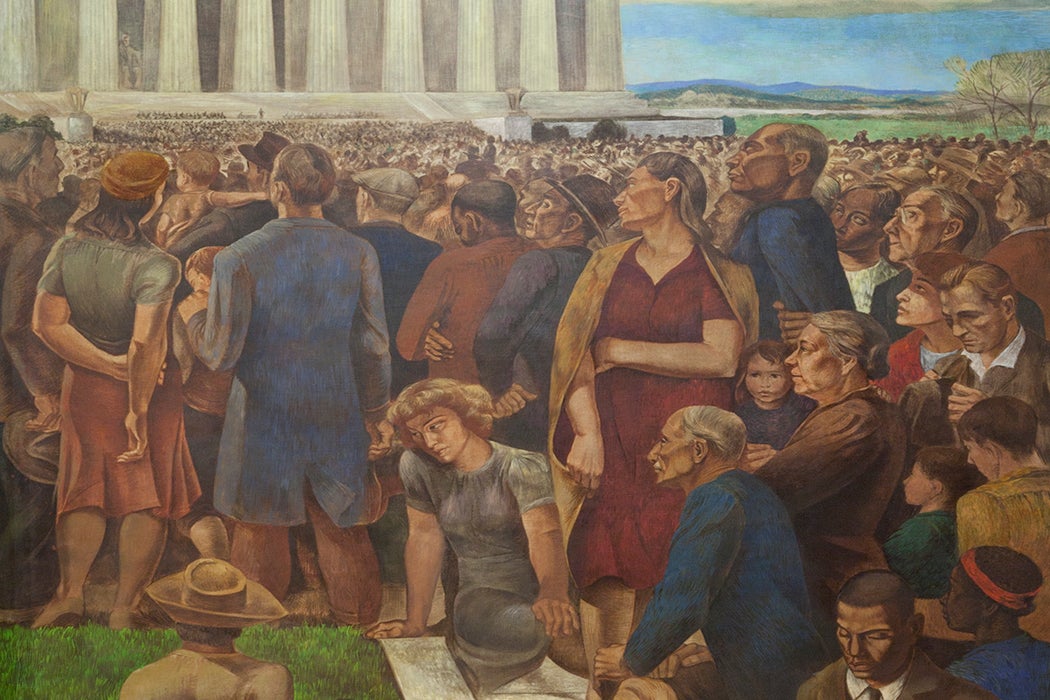What was the first civil rights monument? If your answer is Maya Lin’s 1988-89 monument in Montgomery, Alabama, you’d be off by almost half a century. The history of the “first work of federal art to celebrate black protest” is fairly obscure. Art historian Sara A. Butler reveals the negotiations and compromises that led to Mitchell Jamieson’s mural, “An Incident in Contemporary American Life” (1940-42), being unveiled in the Department of Interior building in Washington, DC.
The backstory begins in 1939, when renowned contralto Marian Anderson wasn’t allowed to perform in Washington DC’s Constitution Hall. The Daughters of the American Revolution (DAR), owners of the Hall, were afraid they would have to offer non-segregated seating if she performed.
The South Philadelphia-born Anderson had already taken Europe by storm. She had sung in Carnegie Hall and was the first African American to perform in the White House. While Southern newspapers refused to call her “Miss Anderson” (“Singer Anderson” was one printed appellation) and she was forced to use “colored” accommodations on tour, Anderson had fans on both sides of the era’s color line.
Both blacks and whites protested the DAR’s rejection of Anderson signaled the birth of the modern civil rights struggle. As part of that protest, Eleanor Roosevelt resigned from the DAR. Her husband, the President, and his Secretary of the Interior, invited Anderson to perform on the steps of Lincoln Memorial. An integrated audience of seventy-five thousand filled the Washington Mall on Easter Sunday, 1939, to hear Anderson’s emotional “Freedom Concert.”
A collaborative effort to commemorate this event started just days after the concert. Butler details the disparate parties involved: the NAACP; bureaucrats from the Section of Fine Arts, the New Deal office charged with placing public art in federal buildings; the “Black Cabinet,” FDR’s informal advisors of color, including Mary McLeod Bethune (who’s portrayed in the mural). This coalition decided to hold a competition for a mural design that would celebrate Anderson’s concert.
The contest was open to all artists, regardless of color—a first for the New Deal. The winner, Mitchell Jamieson, was not an African-American. Butler calls his painting a “remarkably cool depiction of an event that aroused such emotions.” The audience is the subject of the painting; Anderson is a tiny figure in the distance across a sea of people.
Weekly Newsletter
What’s radical about this example of “government art” is that the audience is interracial, as was the audience for the concert itself. Interracial gatherings were then atypical for the nation’s capital. And yet the most prominent members of the mural’s audience are a black man and a white woman standing together. Butler notes the relationship between the two is ambiguous, but “their closeness goes to the heart of the issue that inspired the concert in the first place,” that is, the DAR’s fear of “race mixing.” Butler describes Jamieson’s achievement: “he indicates that interracial cooperation is a key component of a harmonious future.”
The mural celebrates the people watching the landmark concert and looks forward to integration as the new normal. It also stands as a tribute to a new, activist, notion of government-supported art. This was the first time a federally sanctioned work of art both represented a current event and an episode of the struggle for black freedom. Butler concludes that the mural resulted from the “art of negotiation,” resulting in “a compromise in the best sense of the word, and that is its achievement.”







